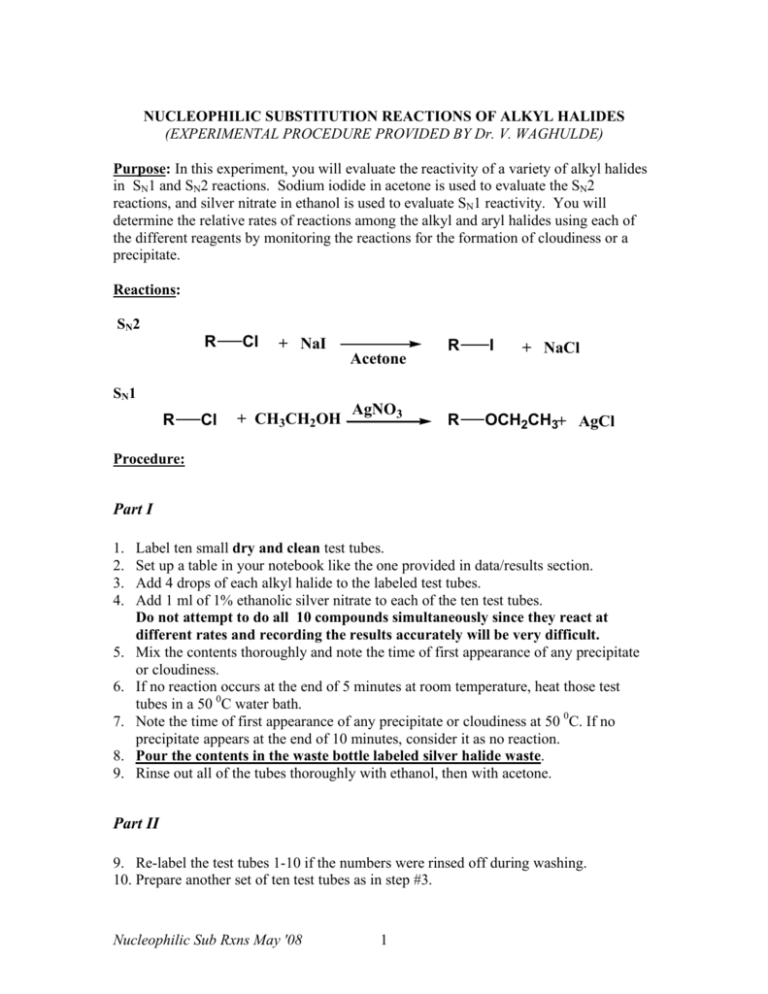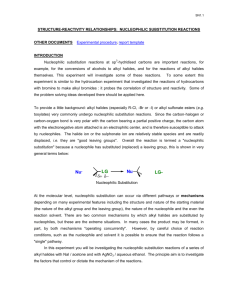R Cl + NaI Acetone R I + NaCl R Cl AgNO3 R OCH2CH3 +
advertisement

NUCLEOPHILIC SUBSTITUTION REACTIONS OF ALKYL HALIDES (EXPERIMENTAL PROCEDURE PROVIDED BY Dr. V. WAGHULDE) Purpose: In this experiment, you will evaluate the reactivity of a variety of alkyl halides in SN1 and SN2 reactions. Sodium iodide in acetone is used to evaluate the SN2 reactions, and silver nitrate in ethanol is used to evaluate SN1 reactivity. You will determine the relative rates of reactions among the alkyl and aryl halides using each of the different reagents by monitoring the reactions for the formation of cloudiness or a precipitate. Reactions: SN2 R Cl + NaI SN1 R Cl + CH3CH2OH Acetone AgNO3 R I R OCH2CH3+ AgCl + NaCl Procedure: Part I 1. 2. 3. 4. 5. 6. 7. 8. 9. Label ten small dry and clean test tubes. Set up a table in your notebook like the one provided in data/results section. Add 4 drops of each alkyl halide to the labeled test tubes. Add 1 ml of 1% ethanolic silver nitrate to each of the ten test tubes. Do not attempt to do all 10 compounds simultaneously since they react at different rates and recording the results accurately will be very difficult. Mix the contents thoroughly and note the time of first appearance of any precipitate or cloudiness. If no reaction occurs at the end of 5 minutes at room temperature, heat those test tubes in a 50 0C water bath. Note the time of first appearance of any precipitate or cloudiness at 50 0C. If no precipitate appears at the end of 10 minutes, consider it as no reaction. Pour the contents in the waste bottle labeled silver halide waste. Rinse out all of the tubes thoroughly with ethanol, then with acetone. Part II 9. Re-label the test tubes 1-10 if the numbers were rinsed off during washing. 10. Prepare another set of ten test tubes as in step #3. Nucleophilic Sub Rxns May '08 1 11. Add 1 ml of 15% solution of sodium iodide in acetone to each of the ten test tubes. 12. Repeat steps #5—#7. 13. Pour the contents in the waste bottle labeled halogenated organic liquids. Data/Results: Reactivity of Alkyl Halides with Silver Nitrate in Ethanol # Compound 1 Name 1-chlorobutane 2 1-bromobutane 3 2-chlorobutane 4 2-bromobutane 5 7 2-chloro-2methylpropane 1-chloro-2butene(crotyl chloride) benzylchloride 8 bromobenzene 9 bromocyclopentane 6 Structure Room temp. 50 0C Time Time 10 bromocyclohexane Nucleophilic Sub Rxns May '08 2 Obs. Product Obs. Structure Reactivity of Alkyl Halides with NaI in Acetone # Compound 1 Name 1-chlorobutane 2 1-bromobutane 3 2-chlorobutane 4 2-bromobutane 5 7 2-chloro-2methylpropane 1-chloro-2butene(crotyl chloride) benzylchloride 8 bromobenzene 9 bromocyclopentane 6 Structure Room temp. 50 0C Time Time Obs. Product Obs. Structure 10 bromocyclohexane Observation (obs); precipitate, cloudiness, etc. Conclusion In place of your normal "Conclusion" format, instead answer completely all of the questions shown below: For SN1 reaction List the halides tested (by name) in reactivity order (fastest to slowest) in the SN1 reactions. Explain the order in which the 10 alkyl halides reacted and why. Explain the order in which the 20 alkyl halides reacted and why. Explain the order in which the 30 alkyl halides reacted and why. Base your explanations on the following considerations: the nature of leaving group, the effect of structure, steric hindrance, and any other feature. Be sure to explain which alkyl halides did not react and why. (continued) Nucleophilic Sub Rxns May '08 3 For SN2 reaction List the halides tested (by name) in reactivity order (fastest to slowest) in the SN2 reactions. Explain the order in which 10 alkyl halides reacted and explain why. Explain the order in which 20 alkyl halides reacted and explain why. Base your explanations on the following considerations: the nature of leaving group, the effect of structure, steric hindrance, and any other feature. Be sure to explain which alkyl halides did not react and why. ASSIGNED PROBLEMS 1) Examine the following reactions, then label each with the mechanism that is most likely to occur: (after copying the problems into your notebook, circle correct choices) a) KBr + CH3CH2CH2I SN 1 SN2 no reaction likely b) CH3CH2OH + H2O SN1 SN 2 no reaction likely c) CH3CH2OH (CH3)3CBr SN1 SN 2 no reaction likely + 2) Examine the nucleophilic substitution reactions shown below: Rxn #1 CH3CH2Br + Nu:- CH3CH2Nu + Br- Rxn #2 CH3CH2I + Nu:- CH3CH2Nu + I- Which reaction would be expected to proceed at a faster rate? EXPLAIN YOUR ANSWER. END OF EXPERIMENT Nucleophilic Sub Rxns May '08 4











